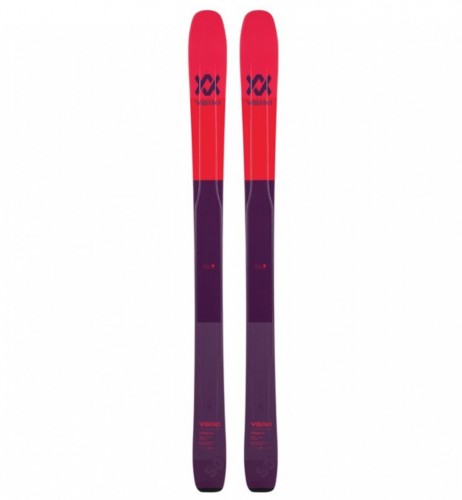The 90eight W got some new colors and graphics this season, but beyond that, all remains the same. See the new ski above.
December 2018Volkl 90eight W Review
Our Verdict
Our Analysis and Test Results
The name Volkl tends to inspire images of hard-charging Germans on slick alpine pistes; these skis live up to the ruggedness of that history, but aside from their brutish character, they don't have much to offer the typical weekend warrior.
Stability at Speed
Given Volkl's propensity for stiffness, we expected these skis to perform well in this category, and they did not disappoint. Once you have acquired the ski's attention and set it moving on course, the 90Eights are content to plug along like a Mack truck on the highway; the trouble is when you decide you want to exit or change lanes. As tester Carrie Pritchard noted, “Sometimes I think it takes an act of God to turn these things!” However, regarding stability and edge hold, they are strong performers.
Carving
Another category in which we hoped these skis would excel, but in this case, they fell somewhat short. Their limited camber underfoot (the ski looks nearly flat, with rocker tips) makes it difficult to get it to bend and grip the snow with any chutzpah. The main issue we had with this ski was that straight out of the factory, the front half of the ski seemed to be tuned excessively sharp, causing a grabby-ness at the end of the turn and not allowing an easy release and start of a new turn.
Once we had the skis professionally retuned, this issue was somewhat abated, but the fear of hooking uphill when we wanted to go down remained. Therefore, the 90Eights don't score nearly as high as the Rossignol Soul 7 HD in this field. One tester talked about the need to propel one's weight forward at the start of a new turn to stay on top of them.
Powder
Fortunately, the stiffness of the 90Eights is mitigated in deeper snow by their wide waist and rockered tips, and we found that they held their own and could stay afloat even in sticky Sierra Cement. Sadly though, before the retune, they were still gripping the snow even in powder and were not conducive to flowy, big mountain powder turns. After having the edges retuned, though, they stayed on top of the fresh and allowed a more fluid experience.
Crud
As with the other categories, the ski was shooting uphill at the end of the turn in crud — perhaps to a greater extent as it was being deflected by the chunky snow. However, after the retune, rough-and-tumble snow conditions are where this ski's power shines through. With a de-tuned front half, the 90eights can be a powerhouse in the chop, using their rigidity to bust through funky snow.
Playfulness
We did not find these skis to be very lively at all; they received our lowest ranking here of any ski in any metric. There is virtually no rebound, especially compared to the Soul 7s and the Elan Ripstick 94. They're in the middle of the bunch when it comes to their weight, and they don't spring into the air very easily. The 90eights have regular camber underfoot, but the camber is so slight that they're nearly flat. Flat describes the experience of skiing them, as well. You can't let up on these boards; you must remind them of who is in charge at all times, which doesn't lend itself to a light-hearted experience.
Bumps
The 90Eights do not love the moguls. They don't smear across the top of bumps well, and they're a bit too stiff to keep them rolling with the punches. They tend to launch their unsuspecting skier into the air rather than submitting to being driven across the undulating surface.
Value
While this ski retails in the upper half price-wise of the skis we tested, we think it is a reasonable price for this ski. As many skiers might like to have them de-tuned, it may be worth considering that tuning cost of approximately $60 on top of the retail cost.
Conclusion
A stiff and powerful ski that sometimes rewards a strong skier in the right conditions, but will punish those who can't handle it.













